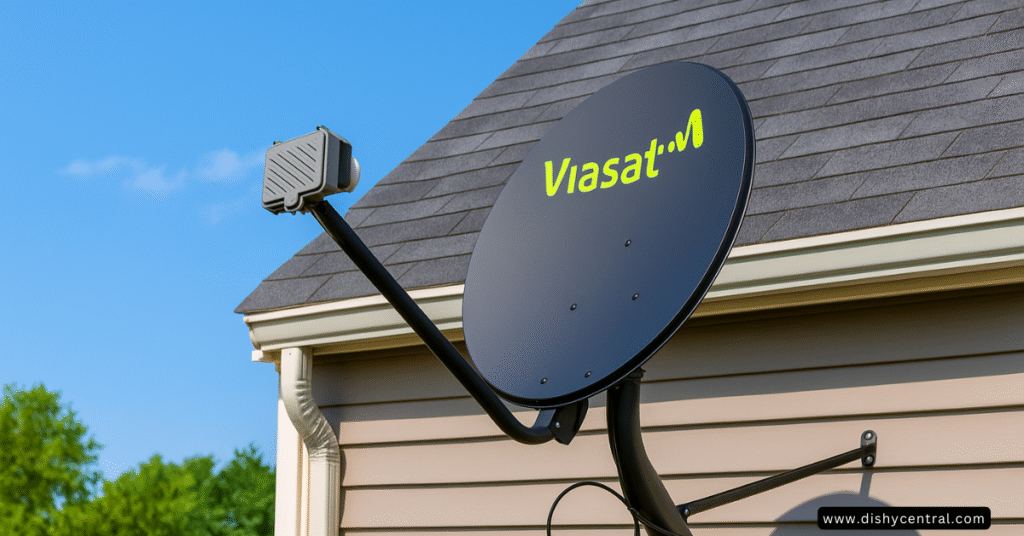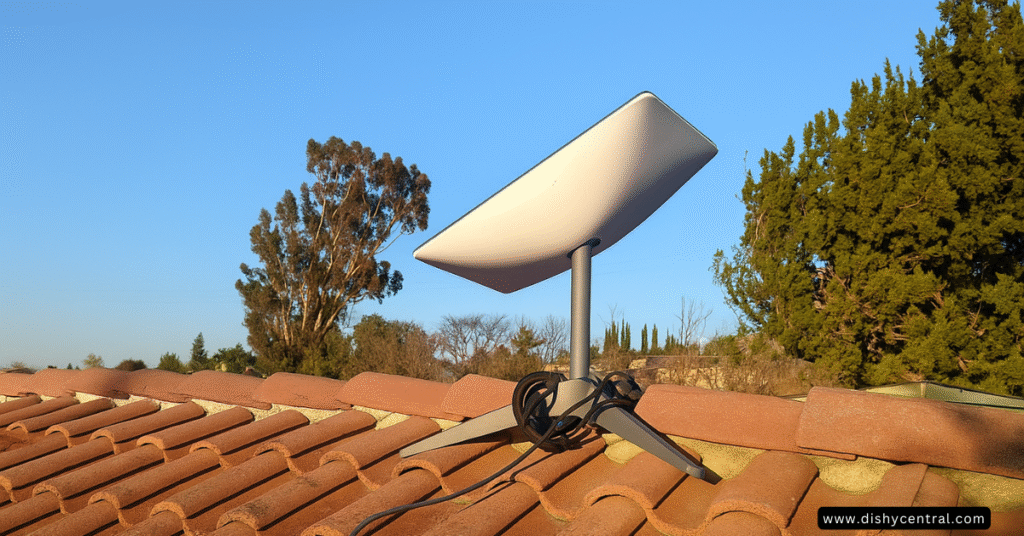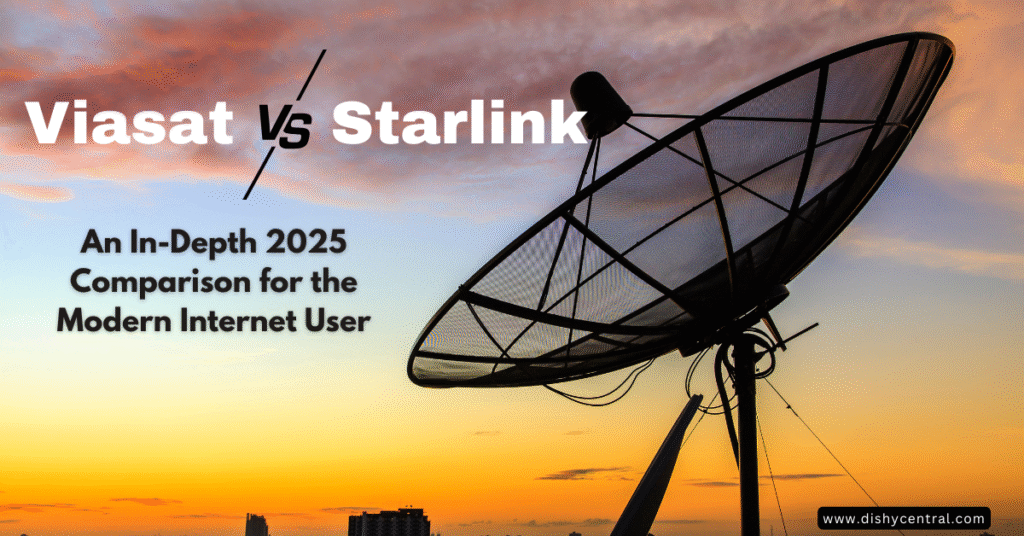If you’re stuck with slow, unreliable internet in a rural area, you’re not alone. Millions of Americans struggle with limited internet options, but satellite internet has emerged as a game-changer. The big question is: which satellite internet provider is best for your needs?
In this comprehensive Viasat vs Starlink comparison, I’ll break down everything you need to know about these two leading satellite internet providers. After analyzing speeds, costs, and real-world performance, you’ll discover why Starlink offers faster speeds and represents the future of rural internet connectivity.
Key Takeaways
- Starlink offers faster speeds (50-250 Mbps) compared to Viasat (up to 150 Mbps)
- Starlink delivers dramatically lower latency (20-40ms vs 600ms+)
- Starlink offers truly unlimited data without throttling
- Viasat has lower upfront costs but comes with data caps
- Starlink is ideal for gaming, video calls, and remote work
- Viasat works for basic browsing and email
- Understanding Satellite Internet Technology: The Foundation of Performance
- 🛰️ Satellite Technology Visualization
- Speed and Performance: Where Starlink Dominates
- Starlink and Viasat Data Policies: Unlimited vs Limited
- Cost Analysis: Investment vs Value
- Coverage and Availability: Reaching Rural Areas
- Installation and Setup: Ease of Use
- Customer Experience and Support
- Specific Use Cases: Which Provider Fits Your Needs?
- Mobile and Portable Options
- The Technology Evolution: Future-Proofing Your Choice
- Viasat vs Starlink: Head-to-Head Comparison Summary
- Making Your Decision: Which Satellite Internet Provider to Choose
- The Bottom Line: Starlink Delivers the Future of Rural Internet
- Frequently Asked Questions
Understanding Satellite Internet Technology: The Foundation of Performance
The fundamental difference between Starlink and Viasat lies in their satellite technology, which directly impacts your internet experience.
Starlink’s Revolutionary LEO Technology
Starlink uses Low-Earth Orbit (LEO) satellites positioned just 340 miles above Earth. This proximity is what makes Starlink satellite internet so revolutionary. The closer satellites mean:
- Lower latency for real-time applications
- Faster internet speeds
- More responsive internet connection
- Better performance for video calls and gaming
Viasat’s Traditional GEO Approach
Viasat Internet relies on geostationary (GEO) satellites positioned 22,300 miles above Earth. While this provides broad coverage from fewer satellites, it creates significant challenges:
- High latency (600ms+) that makes real-time activities frustrating
- Slower speeds during peak usage times
- Limited capacity per satellite
- Less responsive internet service
The technology difference alone explains why Starlink offers faster speeds and better overall performance than traditional satellite internet providers.
🛰️ Satellite Technology Visualization
Explore how LEO and GEO satellites work differently
- Altitude: 340 miles
- Orbit Time: 90 minutes
- Satellites: 5,000+
- Latency: 20-40ms
- Speed: 50-250 Mbps
- Altitude: 22,300 miles
- Orbit Time: 24 hours
- Satellites: 3-5
- Latency: 600-800ms
- Speed: Up to 150 Mbps
Speed and Performance: Where Starlink Dominates
When comparing internet speeds, Starlink consistently outperforms Viasat across all metrics that matter for modern internet usage.
Download Speed Comparison
| Provider | Speed Range | Typical Performance |
|---|---|---|
| Starlink | 50-250 Mbps | Consistently fast |
| Viasat | Up to 150 Mbps | Variable, slower during peak hours |
Starlink offers faster speeds that remain consistent throughout the day. Users regularly report speeds exceeding 100 Mbps, making it suitable for:
- Multiple device usage
- 4K streaming
- Large file downloads
- Video conferencing
- Online gaming
The Latency Game-Changer
This is where Starlink truly shines. Latency measures the delay in data transmission, and it’s crucial for real-time applications:
- Starlink: 20-40ms (comparable to cable internet)
- Viasat: 600ms+ (creates noticeable delays)
Lower latency makes Starlink the clear winner for:
- Video calls without awkward delays
- Online gaming
- VoIP phone services
- Cloud-based applications
- Real-time collaboration tools
Real-World Performance Impact
Starlink internet customers consistently report better experiences for bandwidth-intensive activities. The combination of faster speeds and lower latency creates a reliable internet experience that feels more like traditional broadband.
| Related: Starlink Internet Review: Complete 2025 Guide (Worth It?)
Starlink and Viasat Data Policies: Unlimited vs Limited
One of the most significant differences between these satellite internet providers is their approach to data usage.
Starlink’s True Unlimited Advantage
Starlink offers truly unlimited data without any throttling or data cap restrictions. This means:
- No slowdowns after reaching a threshold
- Consistent speeds regardless of usage
- Freedom to stream, download, and work without worry
- Perfect for home internet replacement
Viasat’s Soft Cap Reality
While Viasat offers “unlimited” internet plans, they implement soft data caps that significantly impact performance:
- Slow speeds after reaching your plan’s threshold
- Throttling during peak hours
- Limited high-speed data allocation
- Frustrating experience for heavy users
Viasat plans may advertise unlimited usage, but the reality of throttled speeds makes them less suitable for modern internet needs.

Cost Analysis: Investment vs Value
Understanding the true cost of satellite internet service requires looking beyond monthly fees to consider long-term value and performance.
Upfront Equipment Costs
| Provider | Equipment Cost | Installation |
|---|---|---|
| Starlink | $599 (one-time) | Self-installation |
| Viasat | $0-300 | Professional installation required |
Starlink equipment requires a higher initial investment, but the Starlink installation process is straightforward and doesn’t require professional help.
Monthly Service Costs
Starlink residential plans offer transparent, fixed pricing:
- Standard plan: Consistent monthly rate
- No contract requirements
- Predictable costs
Viasat plans vary significantly:
- Multiple tiers with different data cap limits
- Pricing varies by location
- Contract options available
Long-Term Value Consideration
When you factor in performance and reliability, Starlink often provides better value despite higher upfront costs. Faster internet speeds and unlimited data mean you’re getting more for your investment.
Coverage and Availability: Reaching Rural Areas
Both providers focus on serving rural area customers, but their availability differs significantly.
Starlink Availability
Starlink availability continues expanding rapidly:
- Active service across most of the continental US
- Minimal waitlists in most areas
- Growing coverage internationally
- Mobile options for RVs and boats
Viasat Internet Coverage
Viasat’s availability offers broad coverage:
- Established service across the US
- Immediate availability in most areas
- No waitlists for standard plans
- Focus on residential service
Installation and Setup: Ease of Use
The installation process can significantly impact your experience with satellite internet.
Starlink’s DIY Approach
Starlink installation is designed for simplicity:
- Self-installation kit included
- Clear instructions and Starlink app guidance
- No professional installation required
- Faster setup process
Viasat’s Professional Installation
Viasat service typically requires:
- Professional installer visit
- Satellite dish positioning and alignment
- Longer setup timeline
- Potential scheduling delays

Customer Experience and Support
Both internet service providers offer different approaches to customer support.
Starlink Customer Support
Starlink customers’ experience:
- Primarily digital support through the Starlink app
- Online troubleshooting resources
- Community forums for tips and advice
- Minimal phone support
Viasat Customer Service
Viasat customers receive:
- Traditional phone-based support
- Professional installation support
- Established customer service infrastructure
- Multiple contact options
| Related: HughesNet vs Starlink: Which Satellite Internet Provider Is Better?
Specific Use Cases: Which Provider Fits Your Needs?
Your internet usage patterns should guide your choice between these satellite providers.
When Starlink is the Clear Winner
Recommend Starlink for users who need:
Remote Work and Business
- Video conferencing without delays
- Cloud application access
- VPN connections
- File sharing and collaboration
Entertainment and Gaming
- Online gaming with competitive latency
- 4K streaming on multiple devices
- Live streaming and content creation
- Social media and real-time interaction
Modern Households
- Multiple connected devices
- Smart home integration
- Educational applications
- Telemedicine appointments
When Viasat Might Suffice
Viasat internet could work for:
- Basic web browsing
- Email and social media
- Standard definition streaming
- Budget-conscious users with minimal needs
Mobile and Portable Options
For users who need internet access on the go, the options differ significantly.
Starlink’s Mobile Solutions
Starlink offers innovative portable options:
- Starlink Mini for ultra-portability
- RV and marine plans
- Pause and resume service capability
- True mobile internet freedom
Viasat’s Limited Mobility
Viasat focuses primarily on fixed residential service with limited mobile options.
The Technology Evolution: Future-Proofing Your Choice
The satellite internet landscape is rapidly evolving, and choosing the right provider means considering future developments.
Starlink’s Expanding Constellation
Starlink satellites continue launching regularly:
- Increasing capacity and coverage
- Improving speeds and reliability
- Adding new features and capabilities
- Leading innovation in satellite service
Viasat’s Traditional Approach
Viasat relies on upgrading existing satellite infrastructure, which limits rapid improvement potential.
Viasat vs Starlink: Head-to-Head Comparison Summary
| Feature | Starlink | Viasat |
|---|---|---|
| Speed Range | 50-250 Mbps | Up to 150 Mbps |
| Latency | 20-40ms | 600ms+ |
| Data Policy | Truly unlimited | Soft caps |
| Equipment Cost | $599 | $0-300 |
| Installation | DIY | Professional |
| Contracts | None required | Optional |
| Gaming Suitable | Yes | No |
| Video Calls | Excellent | Poor |
Making Your Decision: Which Satellite Internet Provider to Choose
After analyzing every aspect of Viasat vs Starlink, the choice becomes clear for most users seeking modern internet service.
Why Starlink Emerges as the Superior Choice
Starlink offers faster speeds, lower latency, and unlimited data that make it the best internet option for:
- Performance: Consistently faster internet that handles modern applications
- Reliability: Reliable internet without frustrating delays or throttling
- Future-Proof: Technology that continues improving
- Value: Despite higher upfront costs, better long-term value
When to Consider Viasat
Viasat might work if:
- Budget constraints make Starlink equipment cost-prohibitive
- Internet needs are extremely basic
- Starlink availability is limited in your area
The Bottom Line: Starlink Delivers the Future of Rural Internet
When you compare Starlink and Viasat, Starlink emerges as the clear winner for users who want modern, reliable internet performance. The combination of faster speeds, lower latency, and unlimited data makes Starlink the best choice for most rural internet users.
While Viasat remains a satellite internet provider option for basic needs, Starlink’s revolutionary LEO technology delivers the faster, more reliable satellite internet that rural communities have been waiting for.
Ready to upgrade your rural internet connection? Starlink represents not just a better internet service today, but an investment in the future of rural connectivity. The days of compromising on internet quality just because you live in a rural area are finally over.
Make the switch to Starlink and experience what truly fast, reliable internet feels like, even in the most remote locations.
Frequently Asked Questions
Is Starlink faster than Viasat?
Yes, Starlink offers faster speeds (50-250 Mbps) compared to Viasat (up to 150 Mbps), with the added benefit of lower latency for better real-time performance.
Which satellite internet provider has better coverage?
Both providers serve rural areas well, but Viasat’s availability is currently broader. However, Starlink availability is expanding rapidly and often has shorter wait times.
Can I game online with satellite internet?
Starlink makes online gaming possible with its lower latency (20-40ms). Viasat’s high latency (600ms+) makes competitive gaming extremely difficult.
Do both providers offer unlimited data?
Starlink offers truly unlimited data without throttling. Viasat advertises unlimited plans but implements soft data caps that slow your connection after reaching certain thresholds.
Which is more expensive long-term?
While Starlink has higher upfront equipment costs, its consistent performance and truly unlimited data often provide better value than Viasat plans with usage restrictions.
How do I cancel my current satellite service?
To cancel your Viasat service or switch providers, contact customer service directly. Starlink offers month-to-month service without long-term contracts.



